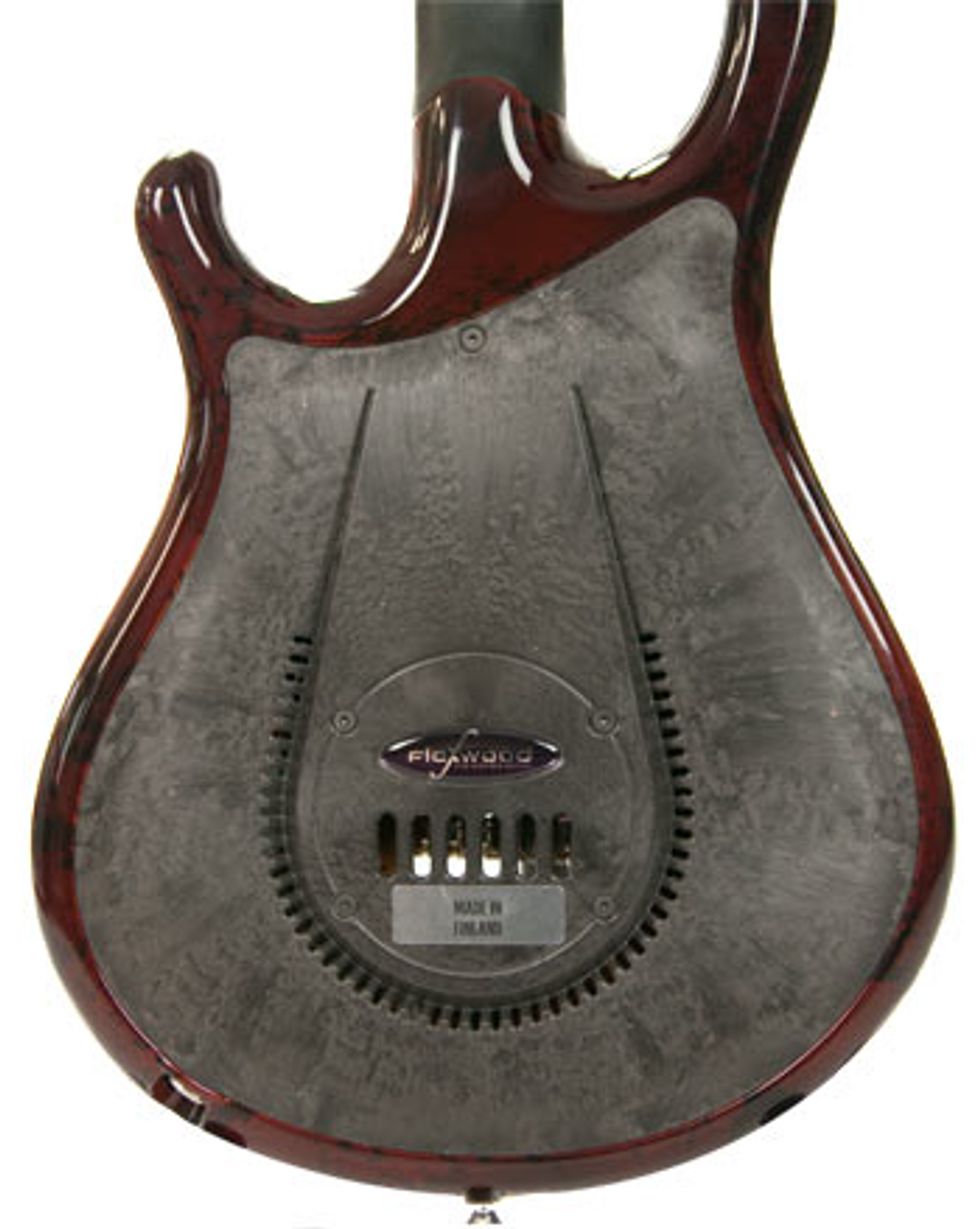| Download Example 1 Neck pickup | |
| Download Example 2 Bridge and middle pickups, double-tracked. | |
| Clips recorded using Schroeder DB7 amp, Planet Waves Custom Pro cables, and Apogee Duet into GarageBand | |
To address these problems, the Finnish guitar company Flaxwood has a line of electrics made from a proprietary material (called flaxwood) that incorporates fresh-growth spruce fiber bound by a resonant synthetic material. The blend produces a uniform and consistent sound that's virtually unaffected by climate. But while Flaxwood’s luthiers make the bodies with 600 tons of pressure-per-square-inch injection molding, they assemble the guitars in the old-school manner—by hand. We checked out the 3S-T Haarii Special—a smart semi-hollow equipped with the unusual pickup configuration of a P-90 in the neck, rounded out with two single-coils.
Bold Design and Top-Notch Construction
 Like all Flaxwood guitars, the Haarii has a comfortably sculpted double-cutaway body and a low profile neck heel. On the back of the instrument you’ll find what looks like an oversized plastic cover but is actually a piece of unfinished flaxwood that is said to contribute to the guitar’s resonance. The neck is made entirely of flaxwood, too.
Like all Flaxwood guitars, the Haarii has a comfortably sculpted double-cutaway body and a low profile neck heel. On the back of the instrument you’ll find what looks like an oversized plastic cover but is actually a piece of unfinished flaxwood that is said to contribute to the guitar’s resonance. The neck is made entirely of flaxwood, too.
Our Haarii was tastefully ornamented, with simple celluloid dot markers, along with trademark f-inlays at the 5th and 12th frets. The guitar sports choice hardware—a self-lubricating Tune-X nut, Gotoh SG360 HAPM locking tuners, and a Schaller LP tremolo. Electronics are top-flight stuff too—a Seymour Duncan SP90-1 Vintage Soapbar and a pair of Duncan SSL-6s. A quarter-inch output jack is thoughtfully positioned out of the player’s way, recessed into the body a few inches east of the bottom strap button.
Our model had a traditional tobacco sunburst finish, revealing the flaxwood’s unusual figuring, which is probably an acquired taste and a little too much like a faux wood dashboard for me. Admittedly, though, I’m conservative when it comes to guitar design and for those who share this aesthetic the guitar is also available in opaque black, white, or gold finishes.
Craftsmanship on our Haarii was impeccable. The 22 medium-jumbo frets were perfectly crowned and dressed, the nut and saddles finely cut. The body’s gloss finish bore no imperfections, and the unfinished neck was absolutely smooth.
Excellent Playability and Tonal Palette
At just over seven pounds, out Haarii was refreshingly lightweight. (Because of flaxwood’s inherent consistency, Haariis should weigh in more-or-less identically.) It was equally comfortable to hold when played in seating or standing position and its contoured edges were easy on the ribs and forearm.
With a 25.5" scale length and a medium contour, our Flaxwood’s neck had a nice vintage feel. It was set up with a perfect low action and was super comfortable along the whole length of the neck. The fretboard’s wide 11” radius made it a breeze to bend the strings more than a whole step without fretting out. Played unplugged, the Haarii was louder and had a bit more resonance than I expected. There were no dead spots on the neck. The notes rang true even at the uppermost frets, and the intonation was spot on.
The electronics on our Haarii are controlled by a conventional five-way switch, which selects the pickups individually, or in combinations of neck-middle and bridge-middle. But the guitar also has a clever blend control, which allowed for a couple of new configurations, including the outer two pickups and all three at once.
To test the Haarii’s amplified sound I played the through a Fender Pro Junior and a Schroeder DB7. I was pleasantly surprised by the guitar’s woody, classic sound and it was easy to forget that about its nontraditional construction materials. Using the single-coil pickups I could access a range of classic Fender-like tones, from Tele-like twang to out-of-phase Strat. In contrast, the neck pickup provided a warmer and thicker voice comparable to the one jazz great Grant Green got on his Gibson ES-330. With the blend control, I dialed in a bit of P-90 to the bridge pickup’s sound, adding heft for single-note soloing.
I found that the Schaller tremolo bar works well for adding some gentle vibrato to the proceedings—better for playing more like Chet Atkins than Joe Satriani. It also enables you to raise pitch a bit for an unusual effect. Aggressive use slightly can disrupt the guitar’s tuning, but on the other hand the Haarii is clearly not intended to be a shred ma-chine.
The Verdict
The Flaxwood 3S-T Haarii Special is an uncommonly versatile semi-hollow incorporating classic sounds and modern playability. It is solidly built and a joy to handle. While its unusual construction materials will not appeal to some, players who are unafraid of new guitar design will find an excellent companion in the Haarii.
Buy if...
you’re looking for classic single-coil and semi-hollow sounds in a single, high-performance guitar.
Skip if...
you’d be troubled by playing a guitar that isn’t made of traditional woods.
Rating...
Street $2359 with Hiscox molded hardshell case - Flaxwood - flaxwood.com |




























